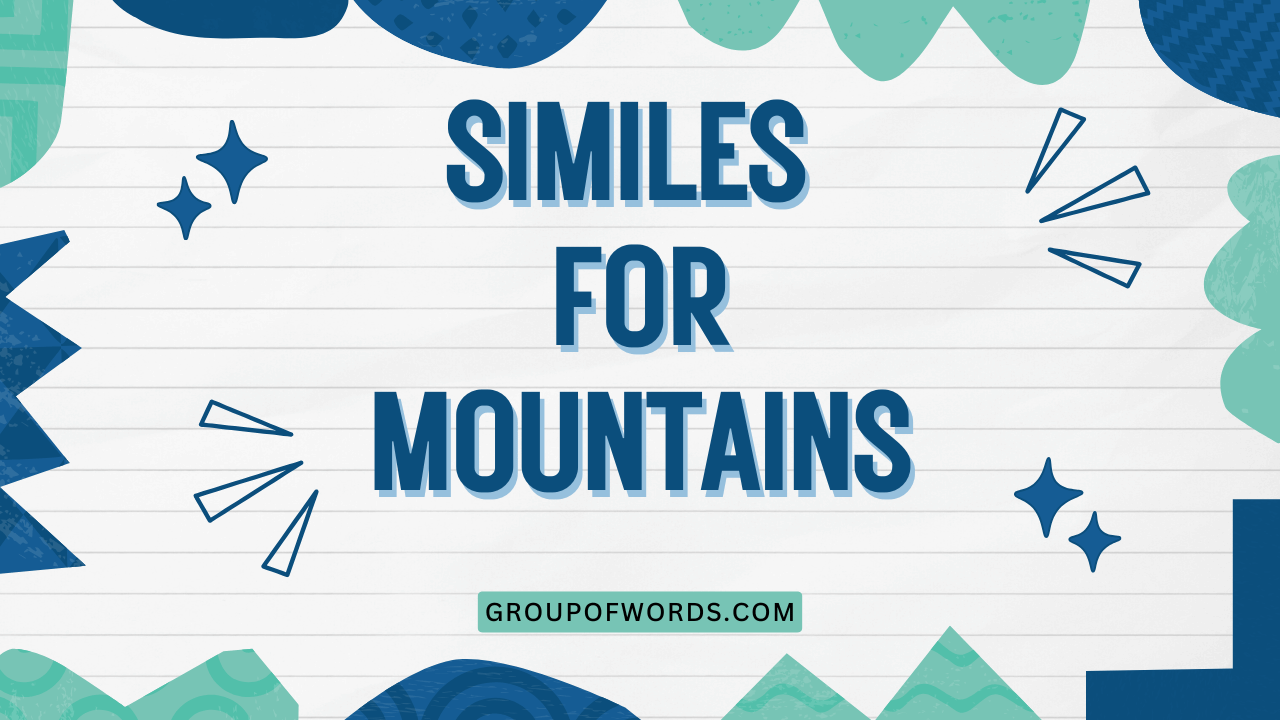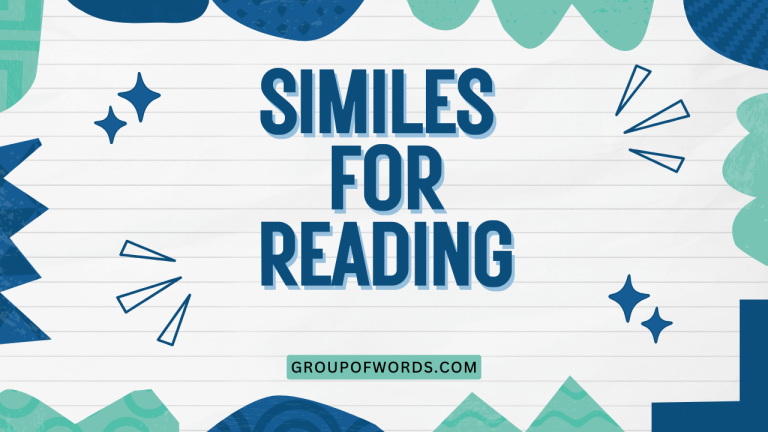Magnificent Mountains: Mastering Similes to Elevate Your Writing
Understanding similes is crucial for adding vivid imagery and depth to your writing. Similes, which compare two unlike things using “like” or “as,” are particularly effective when describing grand and awe-inspiring subjects like mountains.
This article provides a comprehensive guide to using similes to paint a picture of mountains in the reader’s mind, enhancing your descriptive writing skills. Whether you are a student, a writer, or simply an English language enthusiast, this guide will equip you with the knowledge and tools to craft powerful and evocative descriptions.
This article will cover the definition of similes, their structural elements, different types, and numerous examples specifically related to mountains. We will also explore usage rules, common mistakes, and advanced topics to ensure a thorough understanding.
Practice exercises are included to reinforce your learning and help you apply your new skills effectively. Get ready to transform your writing and bring the majestic beauty of mountains to life through the art of similes!
Table of Contents
- Definition of Similes
- Structural Breakdown of Similes
- Types of Similes
- Examples of Similes for Mountains
- Usage Rules for Similes
- Common Mistakes with Similes
- Practice Exercises
- Advanced Topics: Extended Similes and Metaphorical Blends
- Frequently Asked Questions (FAQ)
- Conclusion
Definition of Similes
A simile is a figure of speech that compares two unlike things using the words “like” or “as.” Its primary function is to create a vivid and relatable image in the reader’s mind by drawing a parallel between something familiar and something less so. Similes enhance descriptive writing by adding depth, color, and emotional resonance.
They are a fundamental tool in both prose and poetry, allowing writers to express complex ideas and observations in an accessible and engaging way.
In the context of describing mountains, similes can be particularly effective. Mountains, with their vastness, ruggedness, and often imposing presence, can be challenging to capture in words.
Similes provide a way to relate these characteristics to more common experiences or objects, making the description more understandable and impactful. For example, comparing a mountain to a sleeping giant or a fortress enhances the reader’s understanding and appreciation of its scale and grandeur.
Similes are distinct from metaphors, which directly equate two unlike things without using “like” or “as.” While both are forms of figurative language, similes offer a more explicit comparison, making them often easier to understand and use, especially for learners. The effectiveness of a simile lies in the aptness and originality of the comparison, as well as its ability to evoke a specific feeling or image.
Structural Breakdown of Similes
The structure of a simile is relatively straightforward, typically consisting of three key components: the subject (the thing being described), the comparison word (“like” or “as”), and the analog (the thing to which the subject is being compared). Understanding this structure is essential for crafting effective and grammatically correct similes. Here’s a breakdown:
- Subject: This is the noun or noun phrase that you are describing. In our case, it’s usually a mountain or a feature of a mountain (e.g., peak, slope, face).
- Comparison Word: This is the word that explicitly signals the comparison. It is either “like” or “as.”
- Analog: This is the noun or noun phrase that the subject is being compared to. The analog should share a quality or characteristic with the subject to create a meaningful comparison.
Let’s illustrate this with an example: “The mountain peak was like a jagged tooth against the sky.”
- Subject: The mountain peak
- Comparison Word: like
- Analog: a jagged tooth
The order can sometimes be reversed for stylistic effect, but the core elements remain the same. For instance, “As a sentinel, the mountain stood guard over the valley.” Here:
- Subject: The mountain
- Comparison Word: As
- Analog: a sentinel
It’s important to ensure that the comparison is logical and that the analog effectively highlights the desired quality of the subject. A poorly constructed simile can be confusing or nonsensical, undermining the intended effect.
The strength of a simile lies in its ability to create a clear and compelling connection between the subject and the analog.
Types of Similes
While all similes share the same fundamental structure, they can be categorized based on the type of comparison they make. Understanding these categories can help you choose the most effective simile for a given context.
Here are some common types of similes:
Descriptive Similes
These similes focus on describing the physical appearance or qualities of the subject. They often appeal to the senses, creating a vivid image in the reader’s mind. For example: “The mountain was as gray as weathered stone.”
Emotional Similes
These similes aim to evoke a particular emotion or feeling in the reader. They connect the subject to a feeling that the reader can easily understand. For example: “The summit felt like a victory hard-won.”
Functional Similes
These similes compare the function or purpose of the subject to something else. They highlight what the subject does or how it is used. For example: “The mountain range acted like a natural barrier, protecting the valley.”
Exaggerative Similes
These similes use hyperbole to emphasize a particular quality of the subject. They are often used for dramatic effect. For example: “The mountain was as tall as if it could scrape the sky.”
Understated Similes
These similes use understatement to create a subtle or ironic effect. They are less common but can be very effective in certain contexts. For example: “Climbing the mountain was about as easy as flying to the moon.”
Examples of Similes for Mountains
To truly master the art of using similes to describe mountains, it’s essential to explore a wide range of examples. The following sections provide numerous similes categorized by the aspect of the mountain they describe, offering inspiration and practical guidance for your own writing.
Similes Describing Size and Height
Describing the immense size and towering height of mountains is a common challenge. These similes help convey the scale and grandeur of mountains in a relatable way.
The following table provides examples of similes that effectively capture the size and height of mountains. Each simile offers a unique comparison to help the reader visualize the mountain’s imposing presence.
| Simile | Explanation |
|---|---|
| As tall as skyscrapers, the mountains pierced the clouds. | Compares the mountain’s height to familiar urban structures, emphasizing its immense scale. |
| The mountain rose like a giant’s staircase to the heavens. | Evokes a sense of upward movement and vastness, suggesting a path to the sky. |
| Like ancient sentinels, the peaks stood guard over the land. | Emphasizes the mountain’s imposing presence and timeless quality. |
| As massive as a sleeping titan, the mountain dominated the horizon. | Conveys both size and a sense of latent power, suggesting the mountain’s overwhelming presence. |
| The mountain’s height was like a challenge thrown to the sky. | Suggests the mountain’s height is daring and almost defiant. |
| It loomed as large as a cathedral, casting a long shadow. | Compares the mountain’s size to a large, impressive building, highlighting its grandeur. |
| The mountain stood as high as a wall dividing earth and sky. | Emphasizes the mountain’s role as a boundary and its significant height. |
| Like a colossal wave frozen in time, the mountain towered above us. | Captures the dynamic and powerful nature of the mountain’s height. |
| The mountain stretched as far as the eye could see, like an endless giant. | Highlights the vastness and seemingly infinite extension of the mountain range. |
| As imposing as a fortress, the mountain guarded the valley below. | Conveys a sense of protection and the mountain’s role as a natural defense. |
| The mountain’s peak was like a crown reaching for the sun. | Suggests majesty and the mountain’s aspiration to touch the heavens. |
| As grand as a monument, the mountain celebrated the power of nature. | Emphasizes the mountain’s significance and its representation of natural forces. |
| The mountain’s shadow fell like a dark blanket over the town below. | Illustrates the mountain’s immense size and its impact on the surrounding area. |
| As weighty as the burdens of the world, the mountain seemed immovable. | Conveys a sense of permanence and the mountain’s unyielding nature. |
| The mountain rose like a prayer, silent and reaching upwards. | Suggests reverence and the mountain’s spiritual significance. |
| As prominent as a landmark, the mountain guided travelers from afar. | Highlights the mountain’s visibility and its role as a point of reference. |
| The mountain’s summit was like a beacon, visible for miles around. | Emphasizes the mountain’s height and its ability to be seen from a distance. |
| As timeless as the stars, the mountain had stood for millennia. | Conveys a sense of enduring presence and the mountain’s ancient history. |
| The mountain seemed as eternal as the concept of time itself. | Emphasizes the mountain’s permanence and its connection to the passage of time. |
| Like a natural pyramid, the mountain stood as a testament to nature’s architecture. | Compares the mountain to a structured, monumental form, highlighting its impressive design. |
| The mountain stood as a giant, unyielding to the passage of time. | The mountain is compared to a giant, emphasizing its strength and resistance to the effects of time. |
| Rising like a fortress, the mountain seemed impenetrable. | The mountain is likened to a fortress, highlighting its imposing and seemingly unconquerable nature. |
| The mountain’s peak, like a silent sentinel, watched over the valley. | The peak is compared to a sentinel, emphasizing its watchful presence and dominance over the landscape. |
Similes Describing Shape and Form
Mountains come in various shapes, from jagged peaks to rounded slopes. These similes focus on capturing the unique forms and contours of mountains.
The following table presents similes that describe the diverse shapes and forms of mountains. These comparisons help to visualize the unique contours and structures of different mountains.
| Simile | Explanation |
|---|---|
| The mountain’s peak was like a shark’s tooth, sharp and menacing. | Conveys the jagged and dangerous nature of the mountain’s summit. |
| The mountain’s slopes were as smooth as a sleeping cat’s back. | Emphasizes the gentle and rounded form of the mountain’s sides. |
| Like a crumpled fist, the mountain range seemed to clench the earth. | Suggests a rugged and powerful form, as if the mountains are gripping the land. |
| The mountain’s form was like a wave about to crash, frozen in stone. | Captures a sense of dynamic energy and the mountain’s resemblance to a breaking wave. |
| As rounded as a giant’s belly, the mountain sat peacefully on the horizon. | Conveys a sense of fullness and contentment, highlighting the mountain’s gentle curves. |
| The mountain’s ridges were like the spine of some ancient beast. | Evokes a sense of age and the mountain’s organic, animalistic form. |
| Like a jagged crown, the mountain’s peaks pierced the sky. | Highlights the irregular and imposing nature of the mountain’s summit. |
| The mountain’s shape was as irregular as a shattered mirror. | Conveys a sense of brokenness and the mountain’s fragmented appearance. |
| Like a fortress of stone, the mountain stood strong and unyielding. | Emphasizes the mountain’s solid and defensive form. |
| The mountain’s silhouette was like a sleeping dragon against the sunset. | Suggests a mythical and powerful presence, highlighting the mountain’s majestic form. |
| As sharp as a knife’s edge, the mountain ridge cut through the air. | Conveys a sense of precision and the mountain’s ability to divide the landscape. |
| The mountain’s face was like a canvas, etched with the stories of time. | Emphasizes the mountain’s history and the marks left by the passage of time. |
| Like a pyramid of nature, the mountain stood as a testament to balance. | Compares the mountain to a structured, stable form, highlighting its natural equilibrium. |
| The mountain’s form was as fluid as a sand dune, constantly shifting with the wind. | Conveys a sense of change and the mountain’s susceptibility to the elements. |
| Like a sculptor’s masterpiece, the mountain was a work of natural art. | Emphasizes the mountain’s beauty and its resemblance to a carefully crafted sculpture. |
| The mountain’s shape was as dramatic as a thundercloud, full of potential energy. | Suggests power and the mountain’s ability to unleash natural forces. |
| Like a giant’s playground, the mountain offered endless opportunities for adventure. | Highlights the mountain’s appeal to exploration and its potential for excitement. |
| The mountain’s ridges and valleys were like the wrinkles on an old man’s face. | Conveys a sense of age and the mountain’s long history. |
| Like a guardian spirit, the mountain watched over the valley with a silent gaze. | Emphasizes the mountain’s protective role and its watchful presence. |
| The mountain’s peak was like a beacon of hope, visible from miles away. | The summit is compared to a beacon, emphasizing its visibility and the hope it inspires. |
| Its slopes, like the folds of a giant’s robe, cascaded down to the foothills. | The mountain’s slopes are likened to the folds of a robe, emphasizing their grandeur and scale. |
| The mountain’s shape was as complex as a maze, challenging to navigate. | The mountain’s form is compared to a maze, highlighting its intricate and difficult-to-traverse nature. |
Similes Describing Texture and Surface
The texture and surface of a mountain can vary greatly, from smooth, snow-covered slopes to rough, rocky faces. These similes help convey the tactile qualities of mountains.
This table features similes that capture the diverse textures and surfaces of mountains, from smooth snow to rough rock, enhancing the reader’s sensory experience.
| Simile | Explanation |
|---|---|
| The mountain’s surface was as rough as sandpaper, scraping against our boots. | Conveys the abrasive and uneven texture of the mountain’s surface. |
| The snow on the mountain was like powdered sugar, soft and inviting. | Emphasizes the smooth and delicate texture of the snow. |
| Like a tapestry woven from stone and ice, the mountain’s surface was intricate and beautiful. | Suggests a complex and artistic pattern, highlighting the mountain’s detailed texture. |
| The mountain’s face was as wrinkled as an elephant’s skin, marked by time. | Conveys a sense of age and the mountain’s weathered texture. |
| As smooth as glass, the frozen lake reflected the mountain’s image. | Emphasizes the clarity and smoothness of the ice, creating a mirror-like effect. |
| The mountain’s rocks were like teeth, jutting out from the earth. | Highlights the sharp and irregular texture of the rocks. |
| Like a patchwork quilt, the mountain’s surface was a mosaic of colors and textures. | Suggests a diverse and varied pattern, highlighting the mountain’s complexity. |
| The mountain’s snow was as crisp as freshly laundered linen. | Conveys a sense of cleanliness and the pristine quality of the snow. |
| Like a giant’s beard, moss hung from the mountain’s rocky face. | Emphasizes the abundance and texture of the moss. |
| The mountain’s surface was as unforgiving as broken glass. | Conveys a sense of danger and the mountain’s harsh texture. |
| As soft as velvet, the moss-covered rocks invited us to rest. | Emphasizes the comfort and inviting texture of the moss. |
| The mountain’s ice was like a diamond, sparkling in the sunlight. | Highlights the brilliance and clarity of the ice. |
| Like a dragon’s scales, the mountain’s rocks shimmered in the sun. | Suggests a mythical and powerful presence, highlighting the mountain’s texture. |
| The mountain’s surface was as varied as the earth itself. | Conveys a sense of diversity and the mountain’s connection to the planet. |
| Like a craggy old man, the mountain was etched with lines of age. | Emphasizes the mountain’s age and the marks left by the passage of time. |
| The mountain’s texture was as complex as a fingerprint, unique and individual. | Suggests individuality and the mountain’s distinct characteristics. |
| As smooth as butter, the ice on the glacier allowed for easy passage. | Emphasizes the ease of movement and the frictionless quality of the ice. |
| The mountain’s rocks were like ancient bones, exposed to the elements. | Conveys a sense of history and the mountain’s vulnerability. |
| Like a fortress wall, the mountain’s face was impenetrable and strong. | Emphasizes the mountain’s defensive nature and its solid texture. |
| The mountain’s rocky surface was as jagged as a broken heart. | The texture of the mountain is compared to a broken heart, conveying a sense of pain or harshness. |
| The mountain’s snow-covered peaks, like a soft blanket, invited rest. | The snow is likened to a soft blanket, emphasizing its comforting and inviting quality. |
| The rugged terrain was as challenging as navigating a maze in the dark. | The terrain is compared to a maze, highlighting its difficulty and complexity. |
Similes Describing Weather and Atmosphere
The weather and atmosphere surrounding mountains can be dramatic and ever-changing. These similes help capture the dynamic and often unpredictable conditions that characterize mountain environments.
This table provides similes to describe the weather and atmosphere around mountains, enhancing the reader’s understanding of the environmental conditions and their impact.
| Simile | Explanation |
|---|---|
| The wind howled around the mountain like a banshee, piercing and relentless. | Conveys the fierce and haunting sound of the wind. |
| The fog clung to the mountain like a shroud, obscuring everything from view. | Emphasizes the density and suffocating nature of the fog. |
| Like a raging beast, the storm attacked the mountain with fury. | Suggests a violent and destructive force, highlighting the storm’s intensity. |
| The sunlight on the mountain was as bright as a spotlight, illuminating every detail. | Emphasizes the clarity and intensity of the sunlight. |
| As silent as a tomb, the mountain was shrouded in a blanket of snow. | Conveys a sense of stillness and the mountain’s isolation. |
| The clouds swirled around the mountain like dancers, graceful and ethereal. | Highlights the beauty and fluidity of the cloud movement. |
| Like a painter’s brushstroke, the sunset colored the mountain’s peaks. | Suggests an artistic and colorful transformation of the landscape. |
| The rain fell on the mountain like tears, washing away the dust. | Conveys a sense of cleansing and the emotional impact of the rain. |
| Like a veil, the mist softened the mountain’s harsh edges. | Emphasizes the gentle and obscuring nature of the mist. |
| The lightning flashed around the mountain like a strobe light, illuminating the darkness. | Highlights the sudden and intense bursts of light. |
| As cold as ice, the wind bit at our exposed skin on the mountain. | Conveys the intense chill and discomfort caused by the wind. |
| The air on the mountain was as thin as paper, making each breath a struggle. | Emphasizes the difficulty of breathing at high altitudes. |
| Like a symphony of nature, the sounds of the mountain filled the air. | Suggests a harmonious and diverse range of sounds. |
| The stars above the mountain shone as bright as diamonds, scattered across the sky. | Highlights the brilliance and abundance of the stars. |
| Like a sentinel, the mountain stood guard against the approaching storm. | Emphasizes the mountain’s protective role and its resilience. |
| The atmosphere on the mountain was as pure as a mountain spring, refreshing and invigorating. | Conveys a sense of cleanliness and the revitalizing quality of the air. |
| As unpredictable as the weather, the mountain demanded respect and caution. | Emphasizes the need for preparedness and awareness in the mountain environment. |
| The mountain air was as crisp as an apple, invigorating and clean. | The air is likened to an apple, emphasizing its freshness and purity. |
| The mountain’s shadow moved like a silent ghost, slowly enveloping the valley. | The shadow is compared to a ghost, highlighting its silent and gradual movement. |
| The wind howled through the peaks as if singing a mournful song. | The wind’s sound is likened to a mournful song, evoking a sense of sorrow or solitude. |
Similes Describing Emotional Impact
Mountains often evoke strong emotions, from awe and wonder to fear and respect. These similes focus on capturing the emotional impact of mountains on those who experience them.
This table provides similes that express the emotional impact of mountains, capturing feelings of awe, fear, respect, and wonder.
| Simile | Explanation |
|---|---|
| Standing at the summit felt like touching the sky, a moment of pure elation. | Conveys the joy and triumph of reaching the mountain’s peak. |
| The mountain’s vastness was like a challenge, daring us to conquer its heights. | Emphasizes the sense of ambition and the desire to overcome obstacles. |
| Like a spiritual awakening, the mountain experience transformed our perspective. | Suggests a profound and life-changing effect. |
| The mountain’s solitude was as comforting as a warm embrace. | Conveys a sense of peace and security. |
| As intimidating as a giant, the mountain inspired both awe and fear. | Emphasizes the sense of respect and the potential for danger. |
| The mountain’s beauty was like a siren’s call, irresistible and enchanting. | Suggests a captivating and alluring quality. |
| Like a test of endurance, the mountain pushed us to our limits. | Emphasizes the challenges and the need for perseverance. |
| The mountain’s silence was as profound as a meditation, calming and centering. | Conveys a sense of inner peace and reflection. |
| Like a sacred place, the mountain evoked reverence and respect. | Suggests a spiritual significance and the need for humility. |
| The mountain’s grandeur was as humbling as a glimpse of the infinite. | Emphasizes the sense of insignificance in the face of nature’s power. |
| As rewarding as a great achievement, reaching the summit filled us with pride. | Conveys the satisfaction and accomplishment of overcoming a challenge. |
| The mountain’s presence was like a constant companion, always there to offer solace. | Emphasizes the sense of support and the mountain’s enduring nature. |
| Like a reminder of our mortality, the mountain made us appreciate the present moment. | Suggests a deeper understanding of life and the importance of living fully. |
| The mountain’s resilience was as inspiring as a phoenix rising from the ashes. | Emphasizes the ability to overcome adversity and the power of renewal. |
| Like a blank canvas, the mountain invited us to create our own adventures. | Suggests endless possibilities and the freedom to explore. |
| The mountain’s challenge was as addictive as a thrilling game, always beckoning us back. | Emphasizes the excitement and the desire for more. |
| As timeless as eternity, the mountain made us feel connected to something greater than ourselves. | Conveys a sense of belonging and the connection to the natural world. |
| The mountain’s majesty felt like a royal audience, demanding respect and humility. | The mountain’s presence is likened to a royal audience, emphasizing its imposing nature and the need for reverence. |
| Reaching the summit was like achieving a lifelong dream, fulfilling and surreal. | The act of reaching the summit is compared to fulfilling a dream, highlighting the sense of accomplishment and wonder. |
| The mountain’s rugged beauty, like a stoic philosopher, offered wisdom through its silence. | The mountain is compared to a stoic philosopher, emphasizing its wisdom and the lessons it imparts through its stillness. |
Usage Rules for Similes
Using similes effectively requires adherence to certain grammatical and stylistic rules. These rules ensure clarity, coherence, and impact in your writing.
Here are some key usage rules to keep in mind:
- Use “like” or “as”: Always include one of these words to signal the comparison. Omitting them turns the simile into a metaphor.
- Compare unlike things: The subject and analog should be different enough to make the comparison interesting and insightful. Comparing similar things is redundant.
- Ensure logical connection: The comparison should be logical and make sense within the context. The shared quality should be apparent to the reader.
- Avoid clichés: Overused similes (e.g., “as strong as an ox”) can make your writing seem unoriginal. Strive for fresh and creative comparisons.
- Maintain consistency: Ensure that the simile aligns with the overall tone and style of your writing. Inconsistent similes can be jarring.
- Consider the audience: Choose similes that your target audience will understand and appreciate. Avoid obscure or culturally specific references that may not be universally accessible.
For example, instead of writing “The mountain was as big as a big thing,” which is vague and uninformative, try “The mountain was as big as a stadium, dwarfing the town below.” This provides a more specific and impactful comparison.
Understanding and applying these usage rules will help you craft similes that enhance your writing and effectively convey your intended meaning.
Common Mistakes with Similes
Even experienced writers sometimes make mistakes when using similes. Recognizing these common errors can help you avoid them and improve your writing.
Here are some frequent mistakes to watch out for:
- Using metaphors instead of similes: Forgetting to include “like” or “as” can unintentionally create a metaphor.
- Incorrect: The mountain was a jagged tooth against the sky. (Metaphor)
- Correct: The mountain was like a jagged tooth against the sky. (Simile)
- Creating illogical comparisons: The comparison should be based on a shared quality or characteristic.
- Incorrect: The mountain was as loud as a library. (Illogical comparison)
- Correct: The mountain was as silent as a library. (Logical comparison)
- Using clichés: Overused similes can make your writing seem unoriginal.
- Cliché: The mountain was as old as time.
- Better: The mountain was as old as the stories whispered by the wind.
- Being too vague: The comparison should be specific enough to create a clear image in the reader’s mind.
- Vague: The mountain was like a thing.
- Better: The mountain was like a fortress, guarding the valley below.
- Mixing metaphors and similes: Avoid combining metaphors and similes in a way that creates confusion.
- Incorrect: The mountain was a fortress, like a sentinel watching over the land. (Mixing metaphor and simile)
- Correct: The mountain was like a fortress, a sentinel watching over the land. (Simile only)
By being aware of these common mistakes, you can refine your use of similes and ensure that your writing is clear, effective, and engaging.
Practice Exercises
To solidify your understanding of similes and their application in describing mountains, complete the following exercises. These exercises are designed to test your knowledge and help you practice crafting effective similes.
Exercise 1: Fill in the Blanks
Complete the following sentences with appropriate similes. Use “like” or “as” to make the comparison.
| Question | Answer |
|---|---|
| 1. The mountain peak was ________ reaching for the clouds. | 1. The mountain peak was like a spire reaching for the clouds. |
| 2. The mountain’s slopes were ________ a gentle giant sleeping. | 2. The mountain’s slopes were as smooth as a gentle giant sleeping. |
| 3. The wind howled around the mountain ________ a tormented spirit. | 3. The wind howled around the mountain like a tormented spirit. |
| 4. The mountain stood ________ a guardian, watching over the valley. | 4. The mountain stood as a guardian, watching over the valley. |
| 5. The snow on the mountain shimmered ________ diamonds in the sun. | 5. The snow on the mountain shimmered like diamonds in the sun. |
| 6. Climbing the mountain felt ________ a test of endurance and will. | 6. Climbing the mountain felt like a test of endurance and will. |
| 7. The mountain’s face was ________ stone, weathered by time. | 7. The mountain’
s face was as stone, weathered by time. |
Exercise 2: Identify the Type of Simile
Identify the type of simile used in each of the following sentences (Descriptive, Emotional, Functional, Exaggerative, or Understated).
| Question | Answer |
|---|---|
| 1. The mountain was as tall as if it could scrape the sky. | 1. Exaggerative |
| 2. The summit felt like a victory hard-won. | 2. Emotional |
| 3. The mountain range acted like a natural barrier, protecting the valley. | 3. Functional |
| 4. The mountain was as gray as weathered stone. | 4. Descriptive |
| 5. Climbing the mountain was about as easy as flying to the moon. | 5. Understated |
Exercise 3: Correct the Mistakes
Identify and correct the mistakes in the following sentences.
| Question | Answer |
|---|---|
| 1. The mountain was a fortress, like guarding the valley. | 1. The mountain was a fortress, likelike a fortress, guarding the valley. |
| 2. The mountain was as loud as silence. | 2. The mountain was as loud asas silent as silence. |
| 3. The mountain was old as time. | 3. The mountain was old asas old as time. |
Advanced Topics: Extended Similes and Metaphorical Blends
Once you’ve mastered the basics of using similes, you can explore more advanced techniques to further enhance your writing. These techniques involve extending similes and blending them with metaphors to create richer, more complex imagery.
Extended Similes
An extended simile is a simile that is developed over several sentences or even a paragraph. Instead of making a simple comparison, you elaborate on the shared qualities between the subject and the analog, providing a more detailed and nuanced description.
For example:
The mountain stood like a silent guardian, its rocky face weathered by centuries of storms. Like an old warrior, it bore the scars of countless battles, each ridge and crevice telling a story of resilience and endurance.
Its presence was a constant reminder of the power of nature, a testament to the forces that shaped the world.
In this example, the simile “like a silent guardian” is extended with additional details that reinforce the comparison, creating a more vivid and impactful image.
Metaphorical Blends
A metaphorical blend involves combining a simile with a metaphor to create a more complex and layered comparison. This technique can add depth and richness to your writing, but it requires careful execution to avoid confusion.
For example:
The mountain was like a fortress, a sentinel of stone guarding the valley below. Its peaks were the ramparts, its slopes the walls, and its presence an unyielding defense against the passage of time.
Here, the mountain is initially compared to a fortress using a simile (“like a fortress”). Then, the different parts of the mountain are described using metaphors (“peaks were the ramparts,” “slopes the walls”), blending the two figures of speech to create a more comprehensive and evocative image.
By experimenting with extended similes and metaphorical blends, you can elevate your writing and create more memorable and impactful descriptions of mountains and other subjects.
Frequently Asked Questions (FAQ)
What is the difference between a simile and a metaphor?
A simile compares two unlike things using “like” or “as,” while a metaphor directly equates them without using those words. Similes are more explicit comparisons, while metaphors are more implicit.
How can I avoid using clichés in my similes?
Strive for originality by thinking of fresh and unexpected comparisons. Consider the specific qualities of the subject you are describing and look for unique analogs that capture those qualities.
Can a simile be too long?
Yes, a simile can be too long if it becomes convoluted or detracts from the main point of your writing. Keep your similes concise and focused, ensuring that they enhance rather than overwhelm your description.
Is it okay to use multiple similes in a single paragraph?
Yes, but use them judiciously. Too many similes can make your writing seem cluttered or distracting.
Make sure each simile serves a purpose and contributes to the overall effect.
How do I choose the right simile for a particular context?
Consider the tone, style, and audience of your writing. Choose similes that align with these factors and effectively convey your intended meaning.
Test different options and select the one that works best.
Conclusion
Mastering the art of using similes is a valuable skill for any writer, especially when describing subjects as grand and complex as mountains. By understanding the structure, types, and usage rules of similes, you can craft vivid and impactful descriptions that bring the beauty and majesty of mountains to life for your readers.
Remember to practice regularly, experiment with different comparisons, and strive for originality in your writing. With dedication and attention to detail, you can elevate your descriptive writing and create memorable and evocative imagery.






